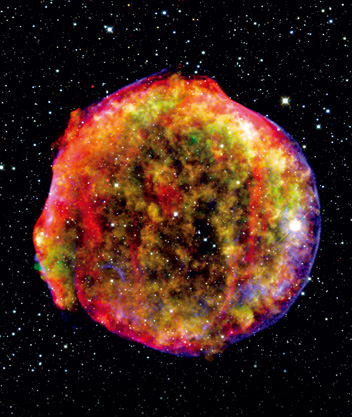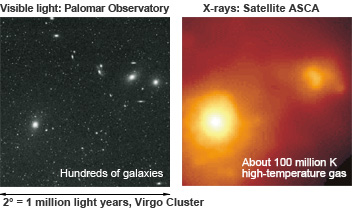
Supernova remnant in Cassiopeia, which Danish astronomer Tycho Brahe discovered in 1572. The photo is a combination of X-ray and middle- and far-infrared ray images. Its estimated distance from Earth is approx. 12,000 light years.
X-rays have the power to potentially reveal 90 percent of normal matter in the universe*, making them a dynamic tool for research and analysis. Illuminated with X-ray light, the universe is a very different place, full of extraordinarily hot gases, colliding galaxies, and forbidding objects such as black holes.
Rockets and Balloons: the First Steps of X-ray Exploration of the Universe
X-ray observation of outer space is not possible from the Earth’s surface because the atmosphere absorbs X-ray radiation. In early 1949, the first rocket-based equipment detected X-rays from the Sun. Then, in June 1962, an Aerobee 150 rocket detected X-rays emitted by Scorpius X-1, a neutron star 9,000 light years away from Earth. It was the first discovery of an extrasolar X-ray source.
Uhuru, the first X-ray research satellite, launched in 1970, detected evidence of black holes and super-dense neutron stars pulling matter from nearby stars. It also discovered vast expanses of hot gas in gigantic systems containing thousands of galaxies.
- *Normal matter is matter we can see with electromagnetic waves. In addition to these substances, the universe contains dark matter and dark energy. We cannot see dark matter with any kind of light — infrared, visible, or X-rays. Dark matter may be made of unknown elemental particles that cannot be explained with standard theories. Scientists believe dark matter makes up 23 percent of the universe, while ordinary matter accounts for only 4 percent. It is believed the remainder of the universe comprises unidentifiable dark energy.
X-rays Find Heat — and Other “Strange” Things
In 1978, the Einstein Observatory recorded images of hot gas in galaxies and galactic clusters. “It was discovered that the main constituents of the clusters are not galaxies, but gaseous matter,” says Dr. Kazuhisa Mitsuda, a professor of high-energy astrophysics at the Japan Aerospace Exploration Agency’s (JAXA) Institute of Space and Astronautical Science. “So, generally speaking, the clusters are surrounded by gaseous matter with temperatures of 10 to 100 million Kelvin. This discovery changed the whole concept of the universe.”
Dr. Mitsuda explains that an object’s temperature determines what wavelength of light — radio, infrared, visible, ultraviolet, X-ray or gamma — it emits. “Depending on the wavelength,” he says, “what you see looks quite different. Our Sun mainly radiates visible light at 6,000 Kelvin and the Earth infrared light at 300 Kelvin. In the universe, super-high temperatures of more than 10 million Kelvin radiate X-rays.”
The Virgo Cluster is a good example of this phenomenon. About 60 million light years from Earth, it contains as many as 2,000 galaxies. When we look at it in visible light, it looks as if it’s surrounded by empty space. But when observed with X-rays, we can see that it’s actually enveloped by gas heated to about 100 million Kelvin. Dr. Mitsuda says X-rays helped calculate that the mass of the gas is seven times that of the cluster.
X-ray observation also supplied proof of the existence of “dark matter,” matter that cannot be seen with light, including X-ray light. Dr. Mitsuda says that the super-hot gas confined in galactic clusters must be contained by gravity. However, we cannot see any matter dense enough to supply this gravitational pull. “It is the mass of dark matter,” he says, “which has 5 to 10 times the mass of the gases and galactic clusters, that is enclosing the high-temperature gases. We presume this matter is made up of unknown elemental particles.”
Black holes are other fascinating entities being studied with X-ray observation. A black hole is a place in space, usually associated with a dying star, where gravity is so strong that even light cannot escape. In some cases, large amounts of gas are being pulled into black holes, creating a huge amount of energy — and X-rays, enabling observation.
X-ray Exploration Continues

X-ray astronomy revealed high-temperature gases between galaxies.
(Photos: Courtesy of Caltech/Palomar and JAXA)
Japan started X-ray exploration of the universe with the satellite Hakucho in 1979. Tenma (1983) and Ginga (1987) followed. In 1993, Japan launched ASCA, the first satellite that could perform both spectral and imaging analysis, leading X-ray astronomy at that time. Japan’s fifth X-ray satellite, Suzaku (2005), had an X-ray spectrometer, an X-ray imaging spectrometer, and a hard X-ray detector.
“Our greatest concern is to understand the universe as it is today by tracing its past,” Dr. Mitsuda says. “To make this possible, we need to develop new observation equipment — and find out what materials are present in the universe.”
Japan plans to launch its sixth X-ray observatory mission, ASTRO-H, in 2014. Its onboard technology will enable observation of locations 8 billion light years away from Earth. According to JAXA, it will explore the “extreme universe that is abundant with high-energy phenomena around black holes and supernova explosions, and observe a cluster of galaxies filled with high-temperature plasma.” Dr. Mitsuda says the ASTRO-H project represents the need to study wider areas of the universe.

The Kelvin scale is an absolute, thermodynamic temperature scale, and has the same degree of magnitude as Celsius. Absolute zero (0 K) is −273.15°C (−459.67°F).
(Information/material: Courtesy of JAXA)
- 1. X-rays Reveal the Mysteries of Cultural Treasures
- 2. What Can X-rays Tell Us about the Universe?
- 3. X-rays Encounter the Infinitesimal World of Atoms

